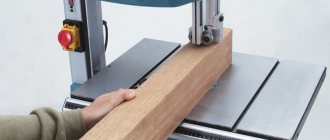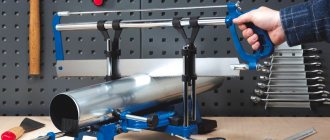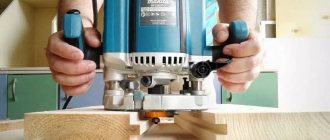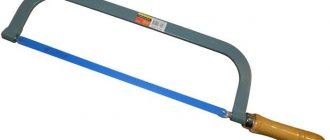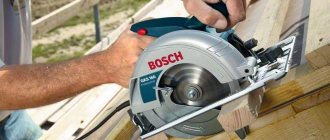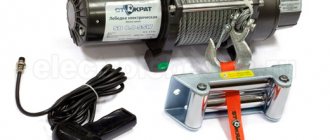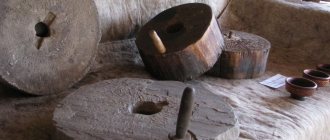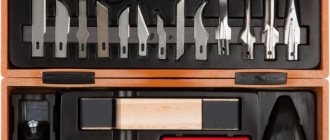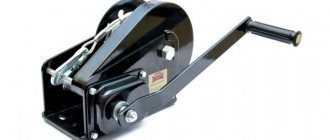It is difficult to imagine the arsenal of tools of a home craftsman or mechanic without a hand saw. Another name for it is a hacksaw. With this tool you can cut down branches in the garden, shorten pickets for a fence and do a lot of other work where you need to change the length of a wooden product: laminate flooring, farm boards, etc.
You may not have thought about it, but the correct choice of a hacksaw determines not only its service life, but also the ease of use and quality of the cut. Let's consider the main parameters of the correct choice of this tool, which is necessary for household and carpentry activities.
Hacksaw rating
For testing, we selected a tool that can be found in every hardware store. We studied the quality and features of the product, ergonomics during use. When compiling the rating, we took into account user reviews, opinions of professional carpenters, mechanics, and gardeners. The main attention was paid to the following characteristics:
- Fabric – the quality and basic parameters of steel were studied;
- Purpose – a specialized and universal tool was tested;
- Teeth – analyzed the size, shape and their compliance with the processing material;
- Handle – should fit comfortably in your hand and not slip while sawing;
- Equipment - they produce kits with a carrying and storage case and a sharpener.
Low metal strength, poor sharpening quality, mechanical defects in the handle - a tool with such a defect was excluded from our rating.
The best manufacturers of imitation timber
The best hacksaws for wood
Boards, timber, floor lath, eurolining - all these materials are cut using a hand saw. The wood is processed along and across the grain, which is taken into account by tool manufacturers. A carpenter with 23 years of experience found out which hacksaw was better for wood. Out of 9 samples, the craftsmen chose 4 options, which attracted attention with the quality of the blade, good sharpening and ergonomic handles.
Armero A531/400
The model of the famous Spanish company was created for working with wood and blanks made from this material. The blade is made of tool carbon steel with a high chromium content, this has improved hardening. The metal holds its edge well, which reduces the cost of routine maintenance. It has good elasticity and resistance to mechanical stress. The protective coating prevents corrosion.
The length of 40 cm makes the saw convenient for cutting 150-200 mm boards, facing strips and moldings. Medium tooth size and pitch (9 pcs per inch), 3D factory sharpening ensures a neat cross cut. Works well with wood of different densities. Does not tear fibers and does not require strong pressure when sawing.
Advantages:
- Light weight;
- Does not deform during operation;
- Low price;
- High performance;
- Difficult to blunt.
Flaws:
- Not detected.
The saw has a two-component handle made of impact-resistant and anti-slip material. The shape takes into account the anatomical features of the palm: the instrument fits well in the hand and does not leave calluses during intensive use.
Gross Piranha 24111
A good hand saw for wood with a fine tooth (frequency 11-12 per inch), developed by German engineers. Easily copes with different species, can be used for cutting chipboard, fiberboard, HDF, laminate. Can be used for cutting expanded polystyrene. Equally effective for transverse and longitudinal cuts of dense, loose wood. Durability is ensured by carbon steel with a protective coating that contains corrosion inhibitors.
It has a 3D sharpening, the edge is treated with Teflon, which reduces the applied physical effort. The cut is smooth, according to user reviews, and is not inferior in quality to processing with a circular saw. The two-component handle is made of rubberized plastic and provides a secure grip. When used for a long time, it does not require effort and does not get stuck in the wood.
Advantages:
- Good sharpening;
- Protective case included;
- Storage hole on hooks;
- Suitable for fine finishing.
Flaws:
- Overcharge.
Irwin Xpert 10505538
The American brand hacksaw is made in Denmark. The blade is made of tool steel 1 mm thick. This makes the model reliable, durable, and tough. A special coating with inhibitors protects against corrosion. At the beginning of the blade there are small teeth that make cutting easy. The main blade is a medium-sized hardened tooth with 3D sharpening and special holes that increase the rate of chip removal.
The handle is two-component, made of impact-resistant polymer and rubberized material. It is secured with three bolts and does not loosen during intensive use. The side surfaces of the handle are made with strict adherence to angles of 45 and 90 degrees, which allows you to avoid wasting time using a measuring tool when cutting boards. Design features make sawing with raw wood easier.
Advantages:
- High performance;
- Wear resistance;
- Hole for hanging during storage;
- Sharp sharpening;
- Clean, neat cut.
Flaws:
- Not detected.
Bison Expert 15168-18
Small folding wood saw for auxiliary work on a construction site, cutting branches. The hacksaw blade is made of heat-treated carbon tool steel and is protected from external aggressive factors by an anti-corrosion coating. Medium-length teeth are arranged in increments of 9 pieces. per inch. The profile of the cutting edge and the length make it easy to cope with sawing 50x50 mm timber and trimming molded products.
The handle is a two-component format, made using durable materials and taking into account the anatomy of the human hand. Does not slip out in wet weather or when force is required. The blade folds and locks securely, providing a high level of safety. A good option for a hiking trip.
Advantages:
- High quality steel;
- High-quality factory sharpening;
- Possibility to replace the blade;
- Sawing raw wood.
Flaws:
- Not suitable for intensive use.
Varieties
By combining the above factors, manufacturers have developed and are now producing standard products with different blades, handle and tooth shapes. To understand how to choose a hacksaw for wood, you first need to familiarize yourself with the existing types of saws.
Type 1: Classic
The main type of saw that almost every man has, even those far from construction and carpentry. This hacksaw can have a blade of any length with a different number of teeth; the tool is often equipped with replaceable blades, which are included with the purchase.
Type 2: Narrow
Its other name is a circular hacksaw. It takes its name from its main application - it cuts out lines of different shapes, and it does it neatly and clearly. It is also used for cutting through round and square holes. The saw blade is narrow, the teeth are frequent, and can be located either on one working plane or on both.
When working with a saw, you should be careful: if you move uncertainly, the blade will turn in the other direction, so when choosing a hacksaw for wood with a narrow blade, you should choose a product made of high-quality hard steel that will not bend during the cutting process.
Type 3: With pad
A hacksaw with a backing is equipped with a stiffening rib (the same backing), which prevents the blade from bending during operation. Thus, the tool is not able to make a cut lower than the width of the working part of the saw.
The backed hacksaw is always equipped with a comfortable handle at an angle of 450 to the blade for easy work execution.
Type 4: Bow
For plumbing, a bow saw is indispensable: it is used for cutting rough parts of the trunk, knots, cutting out figures from plywood and other wood materials, cutting wood along and across the grain. The use of a bow saw is so widespread that it alone can replace a small woodworking machine.
The wide range of work carried out is slightly obscured by the main disadvantages:
- Bulky. A bow saw is a complex structure; its supporting part is made in the form of a large curved arc, to which a narrow, thread-like blade with teeth is attached.
- Fragility. You need to work with the tool extremely carefully: the blade can fly off the mounts and tear during operation; it requires frequent replacement.
Type 5: Reward
The award saw requires a lot of effort to master. This is a tool that resembles a plane. It is equipped with two handles. Its main application is cutting grooves and tenons; the depth of holes and recesses can be of different sizes, and on rocks of any hardness.
Type 6: Folding tool
A mechanical hacksaw that you can take with you on a hike or on vacation. It is compact, lightweight, and completely safe when folded. A folding hacksaw has fine teeth and a short, pointed blade.
The best hacksaws for metal
A special feature of a manual hacksaw for metal is a short and narrow blade with a very small multi-directional tooth. The blade is fixed in a steel frame, replacement is carried out quickly. The tool is characterized by mandatory hardening and the use of high-speed steel. The cutting element is under constant high thermal loads and periodically fails, so several blades are needed to complete the task. Used in home and locksmith workshops.
Vira 801010
The metal model is lightweight; the body is made of durable, corrosion-resistant aluminum alloy. The structure is rigid and does not deform under load. A cutting element 30 cm long is installed; the set includes a 24 TPI blade made of heat-resistant tool steel. The screw clamp allows you to fix the file at a convenient angle.
The handle is made of impact-resistant plastic and rubberized material, fits well in the palm of your hand and does not slip. According to reviews, the profile reduces the load on the hand during intensive and prolonged work. There is no play in the handle, which has a positive effect on the quality of the cut. Designed for processing metal workpieces.
Advantages:
- Quick blade replacement;
- Low price;
- Anatomical handle;
- High strength.
Flaws:
- Not the most reliable blade included.
Matrix 77593
A metal hacksaw for a blade 30 cm long. To replace the cutting element, a screw clamp is provided, with which you can vary the angle of inclination. Two positions are available - 55 and 90 degrees, which expands the application possibilities. The delivery set includes a bimetallic blade with a fine tooth, which ensures accurate cutting of workpieces.
The rigid, reinforced frame has a rectangular cross-section and is protected from corrosion by powder coating. The design has a cavity - this container can store 5 replacement sheets. The tension mechanism securely fixes the blade, which contributes to precision when performing metalwork.
Advantages:
- Light weight;
- The tensioning mechanism does not become loose during use;
- Effectively processes laminate, chipboard;
- Low price;
- Comfortable handle.
Flaws:
- Weak fixation of the container stopper.
Stanley Heavy Duty 1-20-110
It has a durable steel frame that is resistant to deformation and mechanical stress. There is a container in the upper part in which you can store replacement blades. The blade is mounted using a screw spring mechanism, which makes the tension stable. The rigidity of the structure improves productivity and allows the processing of metal workpieces made of hard alloys.
The handle has an anatomical shape and is made of rubberized material. When sawing, it does not slip, does not rub, or cut the palm. The inclined frame design optimizes force. It is equipped with a blade made of tool hardened steel, the teeth are small, frequent, and sharply sharpened. The blade has increased wear resistance.
Advantages:
- Increased service life of all structural elements;
- Reliable fixation of tension force;
- Light weight;
- Carefully cuts metal;
- Good protection against rust.
Flaws:
- Overcharge.
The best garden hacksaws
A hand saw for pruning garden trees is used by summer residents, owners of personal plots, and personnel of municipal municipal services. A special feature of the design is a small, tapered blade, the shape of which is convenient for use in the branchy crown of trees. The size and shape of the tooth make sawing dry and wet wood equally effective. Some models are equipped with devices for cutting at high heights.
Skrab 28154
Garden saw for processing tree crowns. Equipped with a lightweight, durable telescopic aluminum rod that extends up to 5 meters. The pole saw is equipped with a hook that limits slipping, allowing you to quickly and accurately saw off a branch at a great height. The handle is rubberized, made of anti-slip material and provides a comfortable grip. According to user reviews, its shape reduces the load on the hand when working without a barbell.
The blade is made from hardened tool steel, resistant to wear. Protective anti-corrosion coating prolongs service life. The teeth with variable pitch are sharpened and easily cope with branches with a diameter of 10-15 cm. High quality steel stabilizes the quality of the cut. This allows you to do without additional wiring and sharpening.
Advantages:
- Light weight;
- It is convenient to work among branches;
- Blade protection cover;
- Free return.
Flaws:
- Soft metal limiters.
Grinda 8-151853
The model is designed for routine maintenance of garden trees. It has an ergonomic curved handle, the shape of which simplifies sawing in cramped conditions. The handle is made of two-component plastic, does not slip, does not rub during intensive use. There is a hole for hanging storage.
The 30 cm long blade is made of carbon steel and has a chrome-plated surface that is resistant to corrosion. Reverse bevel teeth are designed for cutting dry and wet branches. Induction hardening and triangular sharpening ensure high performance. Supplied with a plastic sheath with belt mounts.
Advantages:
- Good at sawing workpieces of various types;
- Long service life;
- No constant sharpening required;
- Sawing effortlessly.
Flaws:
- Not detected.
Opinel №12
The world-famous French knife manufacturer produces the best garden saws. Wear-resistant tool steel with increased strength, 1 mm thick, is used for production. The model has a folding design, which makes it relevant for summer residents and tourists. It is equipped with a vibrating locking ring that protects against accidental folding and serious injuries.
The fine, double-pointed tooth effectively cuts through dry and damp wood. The “pull” working movement allows you to reduce physical stress on the user. The handle is made of beech wood and is highly durable and resistant to shock loads. The shape of the handle takes into account the specific anatomy of the user's palm.
Advantages:
- Long service life;
- Reliable folding mechanism;
- No regular sharpening required;
- Copes well with branches of any thickness.
Flaws:
- High price.
Selection by purpose
In addition to taking into account the main types of saws, the choice of a hacksaw for wood should be made upon request for a specific type of work:
- Swing for longitudinal sawing;
- Transverse copes well with wood across the grain;
- Tenoning for cutting grooves, tenons and technological recesses in products;
- Circular for cutting holes of different shapes;
- Folding hacksaw for wood
These types of wood hacksaws generalize the above tool models. The choice should be made according to the main purpose for which the selected type of tool is purchased. For the household, it is advisable to purchase a saw with replaceable blades or have several hacksaws of different types in your arsenal .
How to decide
This amount of new information is not easy to put into practice, so we will give you some tips on how to consistently choose the right saw.
- The first factor to consider is what sawn material will be used and what is the desired quality of the cut. Carpenters who work with small wood products choose small saws with a short blade. For a carpenter, it is better to use large teeth and a blade - this master does not require high precision work, speed is a priority. A folding garden hacksaw is ideal for summer residents who will only cut through trees and shrubs.
- Frequency of application. Determine how often you will need to use the tool. If the need arises rarely, take a saw with hardened teeth; if the need for sharpening often arises, use ordinary steel.
- The quality of the steel must be high for a tool with any frequency of use. The higher the class of metal, the better the quality of the product. Before purchasing, take the tool in your hands and carefully bend the blade to 450. Good metal is elastic and, when the end of the saw is released, it will restore its shape without displacing the central axis. If you notice a deviation, return the hacksaw to the seller.
- In this case, price is a guarantee of quality. Of course, provided that the seller is honest and does not offer you a fake. A good product cannot be cheap. Choose in the middle price range, if your wallet allows it - don’t skimp on an expensive saw. Select a manufacturer based on its trust rating and give preference to its products in the store. In most cases, this tactic allows you to avoid buying something unknown instead of a good tool.
- Take the hacksaw tool in your hand. You should feel comfortable holding it. The material used can be solid plastic with a rubberized handle.
By following these simple rules, you can easily choose a wood hacksaw that suits your needs.
The best Japanese hacksaws
The best steel for cutting tools is made in Japan. The Japanese hand saw has an original shape and works when pulled towards itself. The fabric is flexible, durable, and small in thickness. The original mixed tooth shape ensures a very accurate cut. Used for cutting precise grooves, sawing complex tenons, suitable for working in the garden, with decorative materials.
Stanley FatMax 0-20-501
A Japanese wood saw has two cutting edges. Designed for high-precision carpentry work. Provides accurate cutting of cross fibers. Edges with pitches of 7 and 14 TPI allow you to choose the best option, taking into account the density of the wood being processed and the requirements for sawing speed. The blade is flexible, convenient for performing operations in difficult, cramped situations, when there is a shortage of space. Quick replacement of the cutting element is provided.
Equipped with an ergonomic two-component anti-slip handle. The textured surface provides a secure grip. There are holes for easy hanging storage. The absence of play in the handle ensures precision when performing complex cuts.
Advantages:
- High performance;
- Clean cut;
- Long service life;
- Corrosion resistance;
- Wear resistance.
Flaws:
- It is necessary to adapt to flexibility.
Bahco ProfCut PC-9-9/17-PS
The products of the famous Swedish brand are manufactured for a European holding company in Japan. Carbon steel with high wear resistance is used, which ensures long service life. The model is designed for angular and longitudinal cuts of wood of different densities. The unique tooth shape allows you to make a neat cut. Quality - allows you to refuse scheduled sharpening.
The cutting planes are located on both sides, have a pitch of 6-8.5 and 17 TPI. This allows you to perform intensive sawing or make high-precision cuts. The cutting width is less than 1 mm, the absence of chips and burrs allows it to be used when creating decorative elements. The two-component handle fits well in the hand, providing a secure grip.
Advantages:
- Flexible, durable metal;
- Easy replacement of the cutting element;
- Good hardening quality;
- Accurate longitudinal cut;
- Light weight.
Flaws:
- Shortage of replacement sheets.
The best circular saws
How and what to cut wood with
Open in PDFPrint
How to cut wood correctly!???
Technological progress is sweeping the planet and more and more representatives of intellectual work are becoming among tourists. Growing up in cities and deprived of the need to use hand carpentry and carpentry tools. How many of you know what the difference is between a joiner and a carpenter? But this is not about this, but about how to save energy and time when preparing firewood.
What do we mean by the word correctly?
By this word we mean obtaining maximum results with a minimum of time and effort. With one caveat, we need to prepare a lot of firewood! The reservation is significant, because in small volumes you can prepare firewood faster using not the best equipment, but at the same time you will quickly get tired and lose interest in firewood ;-))
Naturally, there is no right technique for all occasions! The technique for sawing wood depends on the tool in your hands.
The first thing you should pay attention to is the position of the handle
If the handle is located above the teeth, you need to saw WITHOUT getting lost. If lower, then To yourself.
Let's start with the most compact and light ones, and gradually reach the legendary "Friendship 2"
Chain and wire saws
Chain and cable saws stand a little apart. When using them, there is simply no choice of the direction of application of force, only along the chain. Although this is not true!
If you stretch the saw in different directions while working and keep its shape close to a straight line, the sawing will be easier, but longer. And if you alternately pull the handles on the side opposite to the log, you can ensure maximum sawing speed, although you will have to sweat, because the teeth will bite deeper into the wood.
This type of saw is the most compact for transportation and one of the lightest, but cutting a lot of firewood with such a saw is extremely difficult physically. The reason here is extremely simple. To ensure flexibility, the chain saw has hinged joints, and so that they do not interfere with sawing, the cutting width of chain saws is the largest among hand tools. Accordingly, in order to cut the same amount of firewood, you need to convert many times more wood into chips ;-))
Thus, this type of saw can be recommended as a work saw, or for occasional preparation of firewood in the warm season. Using such a saw on a winter hike or to prepare a tourist bath, you run the risk of warming yourself not with a fire, but with physical labor, and at the same time washing yourself with your own sweat.
Garden hacksaws and loppers
A characteristic feature of such a tool is that the handle is located either in line with the teeth or moves downwards from the blade.
If you pay attention to the teeth of such a tool, it is easy to notice that the working edges are directed towards the handle, and accordingly you need to cut with such a tool towards yourself.
Why was it done this way?
1. In this case, you can save on metal by making the tool a little thinner, without worrying about it being bent when working in uncomfortable conditions.
2. When working with a tool whose handle is located below the line of teeth, it is irrational to saw away from yourself. Because in this case, the applied force will tear the teeth away from the wood, which will have to be compensated for by additional pressure, and this is a struggle with oneself. In the case of working towards oneself, the blade is pressed against the wood with its teeth by itself, and does not require additional effort.
The figure below shows how forces are distributed when moving the saw towards you (in red) and away from you (with shading).
It can be seen from the figure that when moving towards you, the saw is additionally pressed with its teeth against the wood, and when moving away from you, the pressure on the saw is removed. This ensures ease of work and the possibility of using thinner metal. And this is not only low weight and cost, but also a reduction in the volume of chips per unit of harvested firewood, and therefore less effort.
Does this type of saw have any limitations or disadvantages?
Of course there is! True, they go somewhat beyond the scope of normal use.
The tool is designed to work with dry and wet wood with a diameter of up to ten centimeters.
Which is quite enough for a small summer fire, on which you can boil a small pot, but getting a lot of firewood to dry yourself or keep warm in the winter cold will be problematic.
Especially considering that the thicker the firewood, the less it needs to be cut to obtain the same amount of heat. And sawing “New Year’s” sushi with a short lopper is difficult, long and tedious. Indeed, in addition to the short stroke due to the small blade, this type of tool usually has small and frequent teeth. This increases productivity on thin branches, but makes it difficult to work on thicker trunks, because chips stuck between the teeth and unable to jump out create additional friction for the tool. This, in turn, means additional effort and the possibility of bending the tool, which will add even more friction.
Hacksaws
In skillful hands, a large hacksaw can easily replace a two-handed one, but there are a couple of things.
It will be less convenient for her to cut vertical trunks, because... it will bend under its own weight and it is advisable to choose a hacksaw for wet wood, with a large tooth and possibly notches for removing chips.
How to use a hacksaw?
It’s quite natural that on my own ;-)) After all, their handles are usually located above the line of teeth.
When the handle is positioned above the line of the teeth, by moving the blade forward, you help press the teeth against the wood; by moving the hacksaw towards you, you loosen the pressure. At the same time, there is absolutely no need to think about it. The saw operates under its own weight, and is pressed by the teeth due to the generation of a component as a result of the reaction to friction from forward movement.
It is easy to find hacksaws on sale up to 60 cm in length, which allows you to comfortably harvest wood up to 20-25 cm in diameter. There will be some inconveniences at the time of felling the forest, because... hacksaws are poorly adapted to work in a horizontal plane and bend under their own weight.
This tool can be recommended to individual pyromaniacs who like to cut alone, but at the same time want to prepare a lot of firewood. With the right hands and such a tool, it is quite possible to build a small node.
What to look for when choosing a hacksaw?
- She must have a fairly large tooth
- Smaller ones are also possible, but if there are notches to remove sawdust
- It is advisable to mark the blade stating that it is intended for working on raw wood
- The handle should be comfortable (Warm, as soft as possible and not slippery, ...)
- If you don’t want to worry about how to carry it, it should have a durable standard case! Although it could well be replaced by a piece of garden hose, a thick cambric,... But, this is additional creativity ;-))
Bow saws
These are the performance champions of hand tools. By tensioning the blade with a bow, the blades of these saws are made as narrow and thin as possible, which reduces the amount of sawdust to a minimum and saves a lot of effort during work.
Pros and cons of bow saws when preparing firewood
For the undeniable advantages of ease of sawing, you have to pay with some inconveniences, some of which can be avoided, and some of which you will have to put up with.
Pros:
- Because The blades of these saws are the thinnest and narrowest; when working with them, minimal labor costs are required per unit volume of harvested firewood.
- If you have the skill, you can take only canvas on a hike, and make the beam on the spot from a suitable twig or tree
- With large beams, two people can cut together, which slightly increases productivity. Especially if both participants in the process know what they are doing.
Minuses:
- There is a limitation on barrel diameter
- It's not very convenient to cut down trees. Especially alone, and without the appropriate skill
- Large beams are more difficult to transport, and with their small size, they begin to lose to loppers in terms of the ratio of ease of transportation to the amount of firewood harvested.
Thus, bow saws can be recommended as a three-season solution (spring, summer, autumn), for those who want to cut a lot of firewood with a minimum of effort.
How to cut them correctly? Naturally, like a hacksaw, from yourself.
From the figure it is easy to see that with a beam of this size, it will be difficult to saw through a log lying on the ground and having a diameter greater than the height of the arch of the beam.
Two-handed (Friendship-2)
Champion in terms of the ratio of harvested firewood per unit of effort and its own weight. If you need a lot of firewood, the choice is obvious.
However, in the summer, this tool may be overkill if your plans do not include a camp sauna.
What characteristics should you use when choosing?
Length, shape of cutting surface, size and configuration of teeth, handles and their fastening
Length is one of the most important qualities of a two-handed saw; the longer it is, the larger the size of trees you can swing at ;-)) And the larger these dimensions, the larger your fire, per unit of saw work. But this quality also has a downside. A long two-handed one is more difficult to transport.
Recently, two-handled ones with a length of 80 or 100 cm have become the most common among tourists, although 60 cm are also found. The latter are convenient for the summer, or for preparing not very large trunks. They are lighter and more compact, but at the same time quite productive, although they require more movements.
Shape of cutting surface.
I prefer the traditional, arched shape of the cutting surface, as in the picture above. A saw with this shape cuts quite smoothly, easily and efficiently and throws out sawdust. Saws with a straight cutting surface can also cut well, but at the same time, for thick logs, a Kremlin tooth or its analogues is desirable. Otherwise, productivity drops, because sawdust begins to clog the cut and greatly interfere with the process.
A V-shaped cutting edge is available on sale. In my opinion, this is a perversion, because... It’s not very convenient to saw evenly with such a thing. But since they are for sale, it means someone needs them ;-)) I didn’t come across any photographs of saws with this shape, but when you see them, you’ll understand. It's like two straight edges meeting in the center with a short, sharp arc.
Tooth configuration.
The most traditional and common tooth configuration is regular triangles, which are sharpened and set alternately. One to the right, the other to the left. It is most suitable for a traditional arcuate cutting edge of any length, but works quite well on short versions with a straight edge.
Kremlin tooth and analogues. Works well on thick logs, with a straight cutting edge of the blade. The teeth, with this configuration, alternate in groups. Several pairs of ordinary triangular teeth, set apart and sharpened in different directions, like a traditional plya, then one or two teeth throw out chips. A little shorter, without wiring and with more significant breaks. This configuration allows for increased productivity on thick logs due to better chip ejection and reduced friction.
How to find a compromise between a saw length that is easy to carry and comfortable for maximum performance? I can suggest the following approach. If you are interested in nodes, then you should pay attention to saws a meter or more long (although you most likely won’t find them longer than a meter, but it’s not for nothing that there were long saws at logging sites). If you prefer smaller fires, then it is quite possible to stay at a length of 60 or 80 cm.
How to carry a meter saw if the height of most backpacks does not exceed 80 cm? A good saw allows you to bend yourself under the backpack flap, pressing the handles to the sides at the bottom. Naturally, it is better to point the handles towards the back wall of the backpack. This way they cling less to branches. A good saw, after being unfastened from the backpack, restores its shape, but a bad one is not a pity ;-)) Although, of course, you can carry the saw sticking out of the backpack, remembering the entire literary stock while making your way through the rubble.
Pens
Handles that are slightly beveled inward and to the side are most comfortable to use. There are no such ones on sale; they are made from branches of a suitable diameter and shape. Lasts for many years. I don’t have a picture at hand, but it’s not hard to guess if you close your eyes, relax your hand, and then look at what position the handle should be in.
So how to saw with a two-handed ply?
Like a hacksaw, on your own! Long movements carried out by the oblique muscles of the back and abdomen, as when rowing ;-)) The hand only controls the position of the canvas and does not put pressure on it.
Let us repeat once again the general principles of working with hand saws:
- If the handle is located above the line of the cutting edge, then we saw away from ourselves, if below, then towards ourselves.
- You need to saw with wide and sweeping movements. With the body, turning it around the axis-spine, using the latissimus dorsi and oblique abdominal muscles, and not with the hands. Just like when paddling a kayak.
- A normal saw, designed to work under its own weight, there is no need to put pressure on it. Except in rare cases when you urgently need to cut off a small amount.
- If the saw is two-handed, then there is no need to pull the saw from each other. You need to push it away from you and pull it back a little.
If you know how to saw correctly, you can comfortably work alone with a two-handed saw! Yes, two people are a little faster, because... the saw will work in both directions. In addition, the easiest way to learn how to saw correctly with a two-handed tool is to cut horizontally lying trunks alone.
How can you check which of the two is the better sawer? It's simple, look at which side has more sawdust - it cuts worse ;-))
Let me remind you that by the word worse, we agreed to mean that in this case more energy is spent than is necessary, accordingly, fatigue will set in earlier, and often this happens before it was possible to prepare the required amount of firewood.
Brief summary of saw selection
Chain or two-handed, hacksaw or bow?
Chain or cable
The option is more likely for a rainy day, or summer, when a limited amount of firewood is required, and minimizing the weight of equipment and its volume is relevant.
In this type of loppers, the cutting edge of the teeth is directed towards you, and you need to cut with them towards you
Lopper
Optimal for warm weather and easy production of firewood in small quantities.
You need to cut to yourself!
Most wood hacksaws are designed to work independently
Hacksaw
Demi-season tool. Allows you to prepare a significant amount of firewood with little effort.
Nag from yourself!
The bow saw is designed to work independently
Luchkova saw
The leader, if possible, can prepare as much firewood as possible with minimal effort, in warm or cool seasons.
Nag from yourself!
Two-handed
A champion in extracting firewood, especially from large diameter trunks, but you need to know how to cut.
Nagging from myself ;-)) which is a little not obvious to most at first glance.
Open in PDFPrint
How to choose a hacksaw
To buy a good hacksaw, you need to take into account the scope and intensity of use, requirements for the quality of the cut, and the strength characteristics of the materials. The length and quality of steel used for production are assessed. Performance depends on the shape and size of the teeth, the ergonomics of the handle, and the presence of outlet channels. Only taking these features into account can you buy a good tool that will help solve your problems.
Purpose
They produce different types of hacksaws for working on wood, metal and alloys, which differ in the heat-resistant characteristics of the blade and the size of the teeth. For garden work, they produce models with specific ergonomics, which allow you to comfortably cut branches in the crown of trees and care for tough bushes. For thin, neat cuts of small width, Japanese saws are designed, which resemble abutment models. With their help you can perform complex carpentry work.
Canvas
It is made from tool steel of different grades, which is characterized by strength, flexibility, and resistance to thermal loads. To further improve technical characteristics, the best manufacturers use hardening. The metal must be protected from corrosion. Performance and scope of application depend on the length. Models 25-35 cm are used in the garden, when working with 100x100 mm timber or narrow boards.
It is better for roofers and carpenters to choose a tool with a length of more than 40 cm, this will ensure high productivity and allow them to work with timber 150x150 mm and boards 20-25 cm wide.
Shape and size of teeth
A large wood hacksaw is used for sawing boards, timber used in the installation of power structures, and large-sized workpieces. Large teeth provide high performance, but the cutting width can be several millimeters. For accurate work with eurolining, baseboards, tongue-and-groove floorboards, and fillets, models with a medium tooth are recommended. The best choice for a finisher is a saw with small ones at the beginning of the blade and medium ones along the main length. This format will help you make neat cuts.
The shape in the form of an isosceles triangle is intended for cross cutting. For longitudinal cutting, models with teeth in the shape of an asymmetric triangle are used. A pointed tooth with a ground top is universal, sawing equally well along and across wood fibers. With a pronounced tilt in only one direction, it will be easier to work with the tool, but only in one direction.
Lever
Should provide a comfortable, secure grip. Manufacturers of professional models take into account the anatomical features of the palm, which reduces the vibration load on the hand and eliminates calluses. To prevent the handle from slipping, a composite compound of two materials is used in production: impact-resistant and rubberized plastic. The blade is attached in several places, which protects against play and strong vibrations during the sawing process.
The best manufacturers of laminated timber
How to choose a saw?
The wood saw is available in different versions on the market. How products may differ:
- Tooth shape and size;
- Canvas size;
- The grade of steel from which the working part (blade) is made;
- Handle shape.
A hacksaw with a change in one of the specified parameters can radically change its characteristics. Also, sitting comfortably in the hand of one master, it will not suit another at all. These factors must be taken into account when choosing a tool for different purposes.
Teeth size
This parameter affects the quality and speed of work. For convenience in determining the size and number of teeth, the designation TPI was introduced, indicating the number of teeth in one inch . This parameter can be seen in the description of a hand saw for wood; the value is often written on the blade.
- A wood saw with a large tooth produces a rough cut at high speed. It is useful for cleaning the area from branches, cutting boards for firewood and other activities where you can get by with the rough ends of products and trunks. For such instruments, the tooth size TPI 3...6 is selected.
- For products that need to be cut neatly and evenly, a fine-tooth hacksaw with TPI 7...9 is suitable. This type is used for sawing fiberboard, chipboard, laminate, and in repair work. The productivity of such a tool is significantly lower than that of a coarse-toothed one.
A carpenter's saw is selected primarily based on the size of the tooth. So, for ordinary wood, small and large are suitable, but for “delicate” materials such as fiberboard, a fine-toothed saw is needed. In stores you can now find similar designations: “for wood”, “for drywall”, etc. Their main difference is the size of the teeth, which is optimal for sawing each of the materials indicated on the label.
The teeth are distinguished by shape, depending on this the tool acquires different purposes:
- The hacksaw for longitudinal sawing is equipped with triangular teeth with oblique angles. Their appearance resembles hooks that are sharpened on both sides. Because of this, the saw slides along the wood fibers and cuts the blade smoothly, almost without jagged edges.
- The crosscut tool is equipped with teeth in the shape of an isosceles triangle. A mechanical hacksaw of this type cuts as it passes back and forth, but it can only be used for processing dry wood.
- A manual hacksaw for mixed sawing is equipped with both types of teeth alternately located one after the other. Long curved saws the material in the forward direction; in the reverse movement, the triangles expand the channel for passage and catch shavings and sawdust behind them.
In modern models, teeth alternate with voids. This allows you to use the saw on dry and freshly cut wood; coarse unnecessary fibers are removed through the holes.
Steel selection
To make the tool last longer, you should choose high grades of steel for the production of the blade. It's better if it's stainless.
The teeth can be hardened or regular. Regular saws can be sharpened at home, saws with hardened teeth are disposable, and once worn out, nothing can be done with them. They are easy to recognize by their dark color as in the photo.
Blade length
This parameter is determined by the size and pitch of the saw tooth.
- A mini-hacksaw is always equipped with small, frequent teeth; the length of its blade does not exceed 350 mm;
- A universal hacksaw has an average tooth size and a length of no more than 550 mm;
- The wide hacksaw is equipped with large teeth with an increased pitch, the length of its blade is over 600 mm.
In addition to the length, the canvas can vary in shape. A traditional saw has the shape of a rectangle narrowed on one side. This is a universal type of tool that can be used to cut anything.
The rounded blade is adapted for working with branches and other objects at a distance: it is lightweight and easily glides along the wood without much effort.
Handle shape
This part of the saw determines the ease of work. The tool should fit perfectly into your hand and be comfortable. To make handles, various plastics that are pleasant to the body are used. An important note: the material should not slip if your hand suddenly becomes sweaty. For this purpose, the handle body has recesses and grooves and a rubberized lining.
Which hacksaw is better
A tool designed for carpentry work is poorly suited for caring for trees, and cannot handle metal workpieces at all. There are no universal models, so the VyborExperta.ru team recommends the following brands, taking into account the scope of application:
- Armero A531/400 – for woodworking in the home workshop;
- Gross Piranha 24111 – the choice of a professional carpenter;
- Vira 801010 – for a locksmith workshop;
- Skrab 28154 – for treating tall trees in the garden;
- Opinel No. 12 – the choice of summer residents and tourists;
- Stanley FatMax is a professional solution for complex tasks.
All the models presented in the review are worthy of buyers’ attention, but only the most reliable, productive and convenient tools were awarded the title of best in their class.
Tool selection
Ideal for home use, for example, caring for a large garden, for preparing firewood for a bathhouse, for various tasks in a small workshop, having the entire arsenal of electric saws. So, a jigsaw, reciprocating saw and hacksaw are perfect for making crafts. To cut boards and picket fences, you cannot do without a circular saw. But working in the garden or preparing firewood for a bathhouse requires a chain tool. A chainsaw is not the best option here. It requires gas, it is more powerful and it is not as safe as an electric one. For example, cutting branches on a tree with a chainsaw will be very difficult, but you can cut firewood with an electric chain saw.
The choice of an electric saw depends, first of all, on the tasks it will have to perform, its weight and how comfortable it is to hold it in your hands. If the electric saw is comfortable to hold, it means that you won’t need to put in a lot of effort when working, which means you can make more cuts. And of course, the power of the saw - the more powerful the engine, the more capabilities the tool has, the more reliable its operation and the longer its service life.
